MEDIA: TWO BOOKS ON DRUGS –
Sept. 23, 2021 – The doublethink created by this language exasperates Carl Hart, a professor of neuroscience at Columbia University. “In recent years, psychedelic drugs have become chic,” he writes, observing that “the way drugs are categorized is often discretionary” and depends on who is doing the classifying. Drugs considered “psychedelics,” mostly used and enjoyed by “respectable, middle-class white folks,” have escaped the stigma that applies to other controlled substances, particularly those associated with marginalized social groups and nonwhite ethnicities. The dissociative psychedelic ketamine, for example, is now available, to those who can afford private health care, from hundreds of psychotherapy clinics as a treatment for conditions including depression, anxiety, and PTSD, while its close chemical cousin PCP is still perceived as “angel dust,” a street drug believed to make young Black men physically aggressive and commonly cited in cases of police homicide as a cause of “violent rage behavior.”
The toxicology reports that support this view are usually taken at face value by the media, but Hart presents this received assumption as a racist myth, pointing to the high rates of false positives in PCP toxicology screenings; the misinformation surrounding closely studied episodes such as the 1991 beating of Rodney King, whom officers falsely believed to have taken the drug; and peer-reviewed surveys that have failed to show any link between PCP and violence. Ketamine replaced PCP as a surgical anesthetic because its effects, though similar, were more controllable and of shorter duration. It now benefits from its status as a licensed medicine, which means that it can be prescribed off-label as an adjunct to psychotherapy without passing through the FDA trials required for other psychedelics. PCP “has long been established as a psychedelic,” Hart writes.



